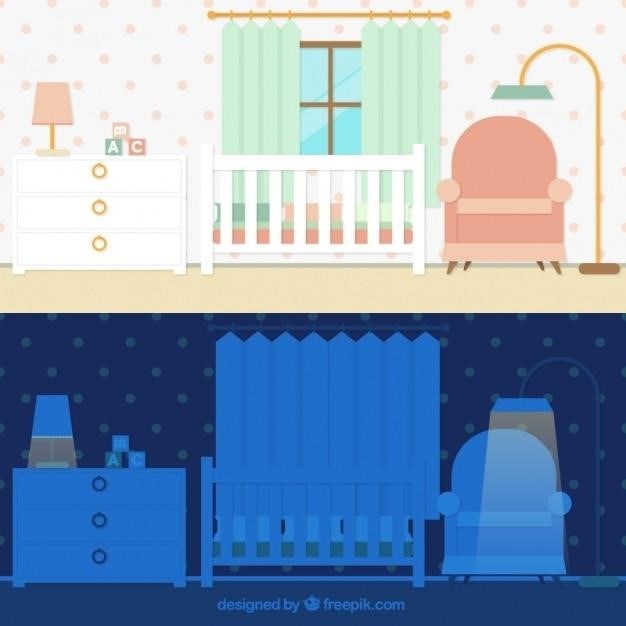4-in-1 Crib Assembly Instructions⁚ A Comprehensive Guide
This guide provides a step-by-step approach to assembling your 4-in-1 crib. Detailed instructions, safety precautions, and troubleshooting tips are included to ensure a safe and successful assembly process. Refer to diagrams and illustrations for visual assistance.

Introduction⁚ Choosing Your 4-in-1 Crib
Congratulations on your decision to purchase a 4-in-1 crib! This versatile piece of furniture offers exceptional value, growing with your child from infancy through toddlerhood and beyond. Before you begin assembly, take a moment to appreciate the features of your chosen crib. Many models, such as the Delta Children Fancy 4-in-1 Crib, boast simple lines and curved corners, while others, like the Canton 4-in-1 Crib, combine style and functionality. Consider the crib’s overall design, material (often strong wood construction), and safety features (such as a non-drop side). A key feature of these cribs is their adaptability. They convert from a crib into a toddler bed, daybed, and finally, a full-size bed (additional rails may be sold separately). Carefully review the included assembly instructions and parts list to ensure you have everything necessary before starting the project. Check for any damage to the parts; if something is broken, contact customer service for replacements. Remember, a properly assembled crib is crucial for your child’s safety and comfort, so take your time and follow the steps meticulously.
Safety Precautions and Warnings
Prior to commencing assembly, meticulously read all instructions. Keep these instructions for future reference. The presence of small parts necessitates keeping children away from the assembly area until completion. Always ensure that all pre-assembled parts are securely tightened. Never use the crib if any parts are missing, damaged, or broken. Contact the manufacturer immediately for replacements. Do not substitute parts. Inspect the crib periodically for any signs of wear or damage. Report any issues to the manufacturer promptly. Avoid scratching or chipping the finish. Do not store the crib or any parts in extreme temperatures or conditions, such as a hot attic or damp basement. The mattress must meet specific size requirements (e.g., minimum dimensions of 51-5/8 inches in length, 27-1/4 inches in width, and 4 inches in thickness for a full-size crib mattress). Use only the recommended mattress; Never use more than one mattress in the crib. Ensure all bolts and fasteners are securely tightened after assembly; periodically check and retighten as needed. Failure to follow these instructions can result in serious injury or death. Register your product for safety alerts and updates at the manufacturer’s website.
Step-by-Step Assembly Instructions⁚ Part 1
Step 1⁚ Lay out all parts and hardware. Identify each component using the provided diagram. Ensure all pre-assembled parts are securely tightened. Begin by attaching the back rail (A) to the back left (B) and back right (C) posts. Use the appropriate bolts (J) and Allen wrench (included). Tighten securely, but leave a slight amount of play (1/2-3/4 turn) for final tightening after complete assembly. Step 2⁚ Attach the side rails (D and E) to the assembled back posts, using the specified bolts (L). Again, secure but leave slight play. Step 3⁚ Now attach the front panel (F) to the front posts (G and H) and the side rails (D and E). Use the provided bolts (M) and Allen wrench. Tighten securely, but remember the slight play allowance. Step 4⁚ Attach the bottom rail (K) to the assembled frame. This will typically involve securing it to the posts and side rails with the appropriate bolts (K). Once again, tighten firmly but retain a small amount of looseness. Before proceeding to Part 2, double check the stability of the assembled structure. Ensure all joints are secure and no components are loose or wobbly. Refer to the diagram for visual guidance throughout the process.
Step-by-Step Assembly Instructions⁚ Part 2
Step 5⁚ Attach the footboard (H) to the assembled crib frame. This usually involves securing it to the bottom rail (K) and the back posts (B and C) using the appropriate bolts and the Allen wrench. Ensure the footboard is properly aligned and securely fastened. Step 6⁚ Carefully position the mattress support to its lowest setting. This will allow for easy access while assembling the remaining components. Step 7⁚ Install the mattress support. This may involve attaching it to the side rails, bottom rail, and footboard. Use the provided hardware, tightening securely, but leaving the slight play as before. Check for stability and ensure the mattress support is level. Step 8⁚ Once the mattress support is secure, carefully place the crib mattress onto the support. Ensure the mattress fits snugly within the crib frame. Step 9⁚ Final Tightening⁚ Return to each bolt and tighten completely. This step ensures the structural integrity of the assembled crib. After this step, carefully inspect the crib for any loose components or wobbly parts. Address any issues before proceeding. Remember to keep all small parts away from children until assembly is completely finished.
Converting the Crib⁚ Toddler Bed Conversion
Transforming your crib into a toddler bed is a straightforward process. Begin by removing the crib’s higher side rail. This usually involves unscrewing bolts or removing other fasteners securing the higher rail. Carefully store these components for future use or for potential reassembly as a crib. Next, locate the toddler guardrail (sold separately). This additional safety feature prevents your child from rolling out of the bed. Securely attach the toddler guardrail to the remaining side of the crib frame, following the manufacturer’s instructions. Use the provided hardware. Make sure it’s fastened securely. Always double check that all hardware is tight. Ensure the guardrail is firmly attached and stable; Once the guardrail is securely in place, your crib is now converted into a safe and comfortable toddler bed. Remember to always supervise young children around the bed. Consult your crib’s manual for precise instructions and diagrams specific to your model. You may need additional hardware and tools.
Converting the Crib⁚ Daybed Conversion
Converting your crib into a daybed offers a versatile space for relaxation or playtime. This conversion typically involves removing the higher side rail and possibly the footboard, depending on your crib’s design. Consult your instruction manual for specific details on your model. Carefully remove any screws or bolts connecting these components to the crib frame. Save these parts for future use, should you wish to revert the crib back to its original configuration. Once these components are removed, the remaining frame will form the base of your daybed. You might need to adjust the mattress support to accommodate the lower height of a daybed mattress. The process might involve repositioning or removing existing slats. Some cribs require additional hardware for a stable daybed conversion. Check your manual to confirm. After making these adjustments, your crib is transformed into a daybed. You might want to add a comfortable mattress and bedding to complete the transformation. Remember to check the stability of the daybed before allowing children to use it. Ensure all connections are secure.
Converting the Crib⁚ Full-Size Bed Conversion
Transforming your crib into a full-size bed is a significant upgrade, extending its lifespan and adapting to your child’s growth. This conversion usually requires additional components, such as full-size bed rails, which are often sold separately. Before starting, ensure you have all the necessary parts. Carefully examine your crib’s instruction manual for detailed diagrams and steps specific to your model. The conversion typically involves detaching the existing crib side rails and attaching the full-size bed rails. This may require removing existing hardware and inserting new bolts or screws. Pay close attention to the alignment of the rails to ensure the bed frame is stable and sturdy. You may need to adjust the mattress support system to accommodate the dimensions of a full-size mattress. Some cribs might require adding support slats or modifying the existing structure. Always refer to your instruction manual for precise guidance. Once the rails are securely attached, carefully check the stability of the assembled bed. Ensure all connections are tight and stable before placing the mattress. A full-size mattress is necessary for this conversion. Remember to always prioritize safety and follow the manufacturer’s instructions closely throughout the process.
Troubleshooting and Frequently Asked Questions
Encountering difficulties during assembly or conversion? This section addresses common issues and provides solutions. If parts are missing or damaged, contact customer support immediately for replacements. Don’t attempt assembly with incomplete or damaged components. If bolts won’t tighten properly, ensure the holes are aligned correctly. Use the appropriate tools and apply even pressure. If the crib feels unstable after assembly, double-check all connections and ensure all screws and bolts are securely fastened; Refer to the diagram in your instruction manual. If you have questions regarding specific steps or need clarification, consult the detailed instructions provided. If you still have problems, don’t hesitate to contact customer service. They can provide additional assistance, answer specific questions, or guide you through any challenges you are facing. Remember, safety is paramount. Do not proceed if you encounter any problems that compromise structural integrity or overall safety.

Contacting Customer Support and Warranty Information
Should you require assistance beyond this manual, contacting customer support is recommended. For questions regarding assembly, missing parts, damaged components, or warranty claims, utilize the contact information provided by the manufacturer. This may include a phone number, email address, or a dedicated website support portal. Before contacting support, gather necessary information, such as your crib’s model number, date of purchase, and a clear description of the issue. Having this information readily available will expedite the resolution process. The warranty typically covers manufacturing defects for a specified period, usually one year. Any damage resulting from misuse or improper assembly may not be covered. Check the warranty details carefully. Customer service representatives are available to address your inquiries and provide guidance. They can help troubleshoot problems, explain assembly steps, or answer questions about the product’s features and capabilities. For a quicker response, visit the manufacturer’s website for FAQs, troubleshooting guides, or online chat options.